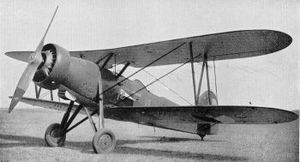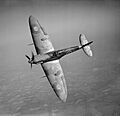Alois Vašátko facts for kids
Quick facts for kids
Alois Vašátko
|
|
|---|---|
| Nickname(s) | Lojzek Amos The Great Amos |
| Born | 25 August 1908 Čelákovice, Austria-Hungary |
| Died | 23 June 1942 (aged 33) English Channel, off Start Point, England |
| Allegiance | |
| Service/ |
Czechoslovak Army Czechoslovak Air Force French Foreign Legion Armée de l'Air Royal Air Force |
| Years of service | 1928–42 |
| Rank | Wing Commander |
| Service number | 83233 |
| Unit | 22nd Infantry Regiment 3rd Artillery Regiment |
| Commands held | 14th Observation Squadron "B" Flight, 312 Squadron |
| Battles/wars | Second World War |
| Awards |
|
Alois Vašátko DFC (born August 25, 1908 – died June 23, 1942) was a brave pilot from Czechoslovakia. He started his military career as an artillery officer. During World War II, he became a famous "flying ace". This means he shot down many enemy aircraft.
He first flew for the French Air Force during the Battle of France. Later, he joined the Royal Air Force (RAF) in Britain. In France, he shot down at least 12 enemy planes in just two months. In the RAF, he shot down another 14 enemy aircraft.
Alois Vašátko led No. 312 (Czechoslovak) Squadron RAF from June 1941. He then commanded the entire Czechoslovak fighter wing in the RAF from May 1942. France honored him with the Croix de guerre and made him a Chevalier de la Légion d'honneur. The United Kingdom gave him the Distinguished Flying Cross.
Sadly, Vašátko died in June 1942. His Supermarine Spitfire plane crashed into an enemy Focke-Wulf Fw 190 over the English Channel.
Contents
Early Life and Military Start
Alois Vašátko was born in 1908 in a town called Čelákovice in what is now the Czech Republic. He was one of five children. His father was a cabinet-maker who was injured in World War I.
His family later moved to Týniště nad Orlicí. There, Alois finished secondary school. He then went to a teacher training college and became a schoolteacher.
Joining the Czechoslovak Army
On October 1, 1928, Vašátko decided to join the Czechoslovak Army. He became an artilleryman, which means he worked with large guns. In 1929, he started training at a military academy.
By July 1931, he became a junior lieutenant. He was put in charge of an artillery unit in Olomouc. He was promoted to Senior Lieutenant in 1935.
In 1935, Vašátko also trained to be an air observer. This meant he would fly in planes to gather information. On December 31, 1936, he moved from the Army to the Czechoslovak Air Force. In 1937, he became the commander of the 14th Observation Squadron. This squadron used Letov Š-328 planes.
Leaving Czechoslovakia
In September 1938, France and the United Kingdom allowed Germany to take over parts of Czechoslovakia. Vašátko continued his training and became a pilot in March 1939. Soon after, Germany took over the rest of Czechoslovakia. The Czechoslovak Air Force was shut down.
Many airmen decided to leave the country secretly. In July 1939, Vašátko traveled through Slovakia and Poland. He then sailed from Poland to France on a ship called the Chrobry.
Flying for France
When Vašátko arrived in France, Czechoslovak refugees were not yet allowed to join the French Air Force. So, he joined the French Foreign Legion first. Later, in November 1939, they were allowed to join the Armée de l'air.
Vašátko trained at a fighter pilot center. By May 1940, he was promoted to Captain. On May 10, 1940, Germany attacked France.

The very next day, Vašátko and two other Czechoslovak pilots joined the Groupe de Chasse I/5 "La Fayette". This group flew new Curtiss H-75-C1 fighter aircraft.
Vašátko quickly became a "flying ace." In just six weeks, he was credited with shooting down 12 German planes. He also likely shot down two more. For his bravery, France gave him the Croix de guerre and made him a Chevalier of the Légion d'honneur.
After France surrendered to Germany in June 1940, Vašátko left. He traveled through Morocco to Gibraltar. From there, he took a ship to Cardiff in Wales, part of the United Kingdom.
Joining the Royal Air Force
The United Kingdom quickly welcomed Czechoslovak airmen into the Royal Air Force Volunteer Reserve. Vašátko became a Pilot Officer and learned to fly Hurricane Mk I planes. He joined the new No. 312 (Czechoslovak) Squadron RAF.
By October 1940, his squadron was based near Liverpool. On October 8, a German Junkers Ju 88 bomber was spotted. Vašátko and two other pilots quickly took off in their Hurricanes. They shot at the German plane, which caught fire and had to land. The surviving German crew were captured.
Vašátko was promoted to Flight Lieutenant in October 1940. In November, he was given command of "B" flight in 312 Squadron. In June 1941, he became the commander of the entire 312 Squadron. The squadron later switched from Hurricanes to Spitfire planes. Vašátko was promoted to Squadron Leader in June 1941.
The RAF had three Czechoslovak fighter squadrons. In 1942, they were grouped into one Czechoslovak fighter wing. On May 1, Vašátko was made its commanding officer. He was promoted to Wing Commander on May 30, 1942.
Vašátko continued to achieve victories. He is credited with shooting down four enemy planes by himself. He also helped shoot down ten more with other pilots.
His Final Flight
By June 1942, 312 Squadron was based at RAF Exeter. On June 23, a group of Douglas Boston bombers went on a mission to bomb an airfield in France. Vašátko led the fighter planes that protected the bombers. These were Spitfires from all three Czechoslovak squadrons.

As the planes were returning to England, German Focke-Wulf Fw 190 fighters attacked them. The Spitfires successfully protected the bombers and destroyed two German planes. However, seven Spitfires were also lost.
Tragically, Vašátko's Spitfire crashed in mid-air with a German Fw 190. Both planes were destroyed. The German pilot survived and became a prisoner of war. But Vašátko's plane went down, and his body was never found.
Achievements and Honors
Alois Vašátko became a flying ace not once, but twice! First in France, and then again in the RAF. Only two other Czechoslovak pilots in the RAF shot down more planes than he did. As a Wing Commander, he was one of the highest-ranking Czechoslovak officers in active service. He had just received his Distinguished Flying Cross award on the day he died.
Remembering a Hero
After Germany surrendered in 1945, Czechoslovakia issued two postage stamps to honor Vašátko.
On June 23, 1946, a memorial plaque was put up in his hometown of Čelákovice. In 2012, on the 70th anniversary of his death, a ceremony was held at his monument. Two Czech Air Force Saab JAS 39 Gripen planes flew over to honor him.
Three streets are named "Vašátkova" after him. One is in Čelákovice, where he was born. Another is in Týniště nad Orlicí, where he grew up. The third is in Prague, in an area where many streets are named after Czechoslovak airmen from World War II.
Because Vašátko has no known grave, his name is written on the Air Forces Memorial in Runnymede, England.
Awards and Recognition
Here are some of the important awards Alois Vašátko received:
 Chevalier de la Légion d'honneur (Knight of the Legion of Honor) from France.
Chevalier de la Légion d'honneur (Knight of the Legion of Honor) from France. Croix de guerre with seven palms and three stars from France.
Croix de guerre with seven palms and three stars from France. Distinguished Flying Cross from the United Kingdom.
Distinguished Flying Cross from the United Kingdom. 1939–1945 Star with a special clasp for the Battle of Britain.
1939–1945 Star with a special clasp for the Battle of Britain. Air Crew Europe Star.
Air Crew Europe Star. Czechoslovak War Cross 1939–1945 (three times).
Czechoslovak War Cross 1939–1945 (three times). Československá medaile Za chrabrost před nepřítelem (Bravery in Face of the Enemy) (twice).
Československá medaile Za chrabrost před nepřítelem (Bravery in Face of the Enemy) (twice). Československá medaile za zásluhy, 1. stupně (Medal of Merit, First Class).
Československá medaile za zásluhy, 1. stupně (Medal of Merit, First Class). Pamětní medaile československé armády v zahraničí (Commemorative Medal of the Czechoslovak Army Abroad).
Pamětní medaile československé armády v zahraničí (Commemorative Medal of the Czechoslovak Army Abroad).
After his death, Vašátko received many more honors. He was promoted to Major and then Lieutenant-Colonel. In 1949, he was given the Military Order of the White Lion. Later, he was promoted to Colonel and then to Major-General. He also received the Milan Rastislav Stefanik Order.
In 2017, the Czech Mint even made special silver and gold coins to honor Alois Vašátko.
Images for kids





